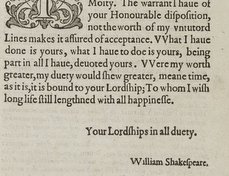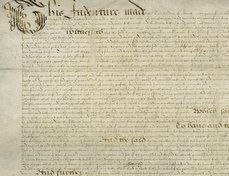Reproduced by permission of Shakespeare Birthplace Trust
Terms of use
The Shakespeare Birthplace Trust has graciously contributed images under a Creative Commons Attribution NonCommerical ShareAlike 4.0 International license. Visitors may download, link to and cite the images for personal research only. Any further use, including, but not limited to, unauthorized downloading or distribution of the images, commercial or third party use, is strictly prohibited. Visitors must contact the Shakespeare Birthplace Trust to request additional use, at: images.scla@shakespeare.org.uk
Document-specific information
Date: July 18, 1598
Repository: The Shakespeare Birthplace Trust, Stratford-upon-Avon, UK
Call number and opening: ER2/23
View online bibliographic record
Robert Bearman, "Conveyance from Thomas Blackford of Butlers Marston, yeoman, to Daniel Smith of Stratford-upon-Avon, yeoman, of a house in Stratford, witnessed by Hamnet Sadler," Shakespeare Documented, https://doi.org/10.37078/472.
Shakespeare Birthplace Trust, ER2/23. See Shakespeare Documented, https://doi.org/10.37078/472.
In the summer of 1598, Thomas Blackford of Butlers Marston sold a house on the north side of Sheep Street, Stratford-upon-Avon, to Daniel Smith. The deed recording the sale, shown here, was drawn up on July 18. William Court, a local attorney, wrote the deed and also witnessed the transaction, together with five other local men: Hamnet Sadler, Richard Nicholls, Hugh Pigeon, Gilbert Charnock and Edward Archard. Sadler, who lived in the house on the corner of High Street and Sheep Street, may have been called on as a near neighbor to the property. Gilbert Charnock, who lived next door to the house that Daniel Smith bought, was certainly acting in that capacity.
Hamlet Sadler, a kinsman and heir to Roger Sadler who had died in 1578, was a well-established burgess of the town. His competent signature implies that he was formally educated, probably at the local grammar school, which may in turn explain why in 1585 Shakespeare had asked him, and his wife Judith, to act as godparents to his twin children.
It was also customary for the vendor to enter into an agreement with the purchaser, secured by bond, to observe all the conditions of the conveyance. A bond to secure this conveyance (now filed at ER 27/8) again drawn up in William Court’s hand, was signed on the same day, and witnessed by the same six men who had attested to the conveyance.
Written by Robert Bearman
Last updated May 15, 2020

















